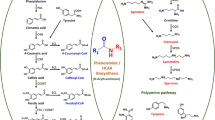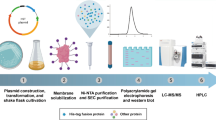Abstract
Plants can produce their own set of defense molecules in an attempt to survive under stressed conditions. Dehydrins play a considerable role in protecting the plants under varied stress situations. We have isolated a novel SK3 type dehydrin from Sorghum capable of protecting the enzyme lactate dehydrogenase in vitro under both cold and high temperature. This protein showed non-canonical migration in a sodium dodecyl sulfate polyacrylamide gel electrophoresis (SDS-PAGE) due to the high hydrophilicity of the protein. The high percentage of glycine and histidine residues present in the protein sequence is responsible for the radical scavenging activity of the protein. The protein also exhibited binding affinity to metal ions owing to the histidine-rich motifs, therefore chelating the metal ions and making them unavailable to systems responsible for generation of reactive oxygen species (ROS). In the presence of specific metal ions, the protein showed reversible aggregation with certain degree of protease resistivity along with induction of secondary structures. The resistivity of the protein to degradation might be implicated in stress situations, thus leading to an increase in the shelf life of the protein. Association with metal ions like copper and zinc at a fairly low concentration increased the protective effect of the SbDHN2 protein for lactate dehydrogenase (LDH) activity to a considerable extent. The synthesis of this dehydrin in stressed plants might help the plant in rendering stress tolerance.











Similar content being viewed by others
References
Alsheikh MK, Svensson JT, Randall SK (2005) Phosphorylation regulated ion-binding is a property shared by the acidic subclass dehydrins. Plant Cell Environ 28:1114–1122. doi:10.1111/j.1365-3040.2005.01348.x
Altschul SF, Gish W, Miller W, Myers EW, Lipman DJ (1990) Basic local alignment search tool. J Mol Biol 215(3):403–410. doi:10.1016/S0022-2836(05) 80360–2
Asghar R, Fenton RD, DeMason DA, Close TJ (1994) Nuclear and cytoplasmic localization of maize embryo and aleurone dehydrin. Protoplasma 177(3–4):87–94. doi:10.1007/BF01378983
Battaglia M, Olvera-Carrillo Y, Garciarrubio A, Campos F, Covarrubias AA (2008) The enigmatic LEA proteins and other hydrophilins. Plant Physiol 148:16–24. doi:10.1104/pp.108.120725
Bhuyan AK (2009) On the mechanism of SDS-induced protein denaturation. Biopolymers 93(2):186–199. doi:10.1002/bip.21318
Bokor M, Csizmok V, Kovacs D, Banki P, Friedrich P, Tompa P, Tompa K (2005) NMR relaxation studies on the hydrate layer of intrinsically unstructured proteins. Biophys J 88:2030–2037. doi:10.1529/biophysj.104.051912
Bravo LA, Gallardo J, Navarrete A, Olave N, Martinez B, Alberdi M, Close TJ, Corcuera LJ (2003) Cryoprotective activity of a cold-induced dehydrin purified from barley. Physiol Plant 118:262–269. doi:10.1034/j.1399-3054.2003.00060.x
Brini F, Saibi W, Hanin M, Amara I, Gargouri A, Masmoudi K (2010) The wheat dehydrin DHN-5 exerts a heat-protective effect on β-glucosidase and glucose oxidase activities. Biosci Biotechnol Biochem 74:1050–1054. doi:10.1271/bbb.90949
Chakrabortee S, Boschetti C, Walton LJ, Sarkar S, Rubinsztein DC, Tunnacliffe A (2007) Hydrophilic protein associated with desiccation tolerance exhibits broad protein stabilization function. PNAS 104:18073–18078. doi:10.1073/pnas.0706964104
Close TJ (1997) Dehydrins: a commonality in the response of plants to dehydration and low temperature. Physiol Plant 100:291–296. doi:10.1111/j.1399-3054.1997.tb04785.x
Corpet F (1988) Multiple sequence alignment with hierarchical clustering. Nucleic Acids Res 16(22):10881–10890. doi:10.1093/nar/16.22.10881
Danyluk J, Perron A, Houde M, Limin A, Fowler B, Benhamou N, Sarhan F (1998) Accumulation of an acidic dehydrin in the vicinity of the plasma membrane during cold acclimation of wheat. Plant Cell 10:623–638. doi:10.1105/tpc.10.4.623
Dean RT, Fu S, Stocker R, Davies MJ (1997) Biochemistry and pathology of radical mediated protein oxidation. Biochem J 324:1–18. doi:10.1042/bj3240001
Dellaporta SL, Wood J, Hicks JB (1983) A plant DNA minipreparation: version II. Plant Mol Biol Report 1(4):19–21. doi:10.1007/BF02712670
Drira M, Saibi W, Brini F, Gargouri A, Masmoudi K, Hanin M (2013) The K-segments of the wheat dehydrin DHN-5 are essential for the protection of lactate dehydrogenase and β-glucosidase activities in vitro. Mol Biotechnol 54:643–650. doi:10.1007/s12033-012-9606-8
Hara M, Terashima S, Kuboi T (2001) Characterization and cryoprotective activity of cold-responsive dehydrin from Citrus unshiu. J Plant Physiol 158:1333–1339. doi:10.1078/0176-1617-00600
Hara M, Terashima S, Fukaya T, Kuboi T (2003) Enhancement of cold tolerance and inhibition of lipid peroxidation by citrus dehydrin in transgenic tobacco. Planta 217:290–298. doi:10.1007/s00425-003-0986-7
Hara M, Fujinaga M, Kuboi T (2004) Radical scavenging activity and oxidative modification of citrus dehydrin. Plant Physiol Biochem 42:657–62. doi:10.1016/j.plaphy.2004.06.004
Hara M, Fujinaga M, Kuboi T (2005) Metal Binding by citrus dehydrin with histidine rich domains. J Exp Bot 56:2695–2703. doi:10.1093/jxb/eri262
Herzer S, Kinealy K, Asbury R, Beckett P, Eriksson K, Moore P (2003) Purification of native dehydrin from Glycine max cv., Pisum sativum, and Rosmarinum officinalis by affinity chromatography. Protein Expr Purif 28:232–240. doi:10.1016/S1046-5928(02)00702-7
Houde M, Daniel C, Lachapelle M, Allard F, Laliberté S, Sarhan F (1995) Immunolocalization of freezing-tolerance-associated proteins in the cytoplasm and nucleoplasm of wheat crown tissues. Plant J 8:583–593. doi:10.1046/j.1365-313X.1995.8040583.x
Hughes S, Graether SP (2011) Cryoprotective mechanism of a small intrinsically disordered dehydrin protein. Protein Sci 20:42–50. doi:10.1002/pro.534
Hughes SL, Schart V, Malcolmson J, Hogarth KA, Martynowicz DM, Tralman Baker E, Patel SN, Graether SP (2013) The importance of size and disorder in the cryoprotective effects of dehydrins. Plant Physiol 163:1376–1386. doi:10.1104/pp. 113.226803
Hundertmark M, Hincha DK (2008) LEA (late embryogenesis abundant) proteins and their encoding genes in Arabidopsis thaliana. BMC Genomics 9:118. doi:10.1186/1471-2164-9-118
Jiang MY (1999) Generation of hydroxyl radicals and its reaction to cellular oxidative damage in plants subjected to water stress. Acta Bot Sin 36:229–234
Kazuoka T, Oeda K (1994) Purification and characterization of Cor85- oligomeric complex from cold-acclimated spinach. Plant Cell Physiol 35:601–611
Kim EC, Lee HS and Choi DW (2012) Sequence variability and expression pattern of the dehydrin gene family in Populus tremula x Populus alba var. glandulosa. Plant Omics 5: 122
Kovacs D, Kalmar E, Torok Z, Tompa P (2008) Chaperone activity of ERD10 and ERD14, two disordered stress related plant proteins. Plant Physiol 147:381–390. doi:10.1104/pp. 108.118208
Labhilili M, Joudrier P, Gautier MF (1995) Characterization of cDNAs encoding Triticum durum dehydrins and their expression patterns in cultivars that differ in drought tolerance. Plant Sci 112:219–230. doi:10.1016/0168-9452(95)04267-9
Laemmli UK, Favre M (1973) Maturation of the head of bacteriophage T4. I. DNA packaging events. J Mol Biol 80:575–592. doi:10.1016/0022-2836(73)90198-8
Lehmann S (2002) Metal ions and prion diseases. Curr Opin Chem Biol 6:187–192. doi:10.1016/S1367-5931(02)00295-8
Lin CT, Thomashow MF (1992) A cold-regulated Arabidopsis gene encodes a polypeptide having potent cryoprotective activity. Biochem Biophys Res Commun 183:1103–1108. doi:10.1016/S0006-291X(05)80304-3
Lopes GK, Schulman HM, Hermes-Lima M (1999) Polyphenol tannic acid inhibits hydroxyl radical formation from Fenton reaction by complexing ferrous ions. Biochim Biophys Acta 1472:142–152. doi:10.1016/S0304-4165(99)00117-8
Mittler R (2002) Oxidative stress, antioxidants and stress tolerance. Trends Plant Sci 7:405–410. doi:10.1016/S1360-1385(02)02312-9
Momma M, Kaneko S, Haraguchi K, Matsukura U (2003) Peptide mapping and assessment of cryoprotective activity of 26/27-kDa dehydrin from soybean seeds. Biosci Biotechnol Biochem 67:1832–1835. doi:10.1271/bbb.67.1832
Mouillon JM, Eriksson SK, Harryson P (2008) Mimicking the plant cell interior under water stress by macromolecular crowding: disordered dehydrin proteins are highly resistant to structural collapse. Plant Physiol 148:1925–1937. doi:10.1104/pp. 108.124099
Mu P, Feng D, Su J, Zhang Y, Dai J, Jin H, Wang J (2011) Cu2+ triggers reversible aggregation of a disordered His-rich dehydrin MpDhn12 from Musa paradisiaca. Journal of Biochemistry 150(5):491–499. doi:10.1093/jb/mvr082
Mundy J, Chua NH (1988) Abscisic acid and water-stress induce the expression of a nove1 rice gene. EMBO J 7:2279–2286
Ouellet F, Houde M, Sarhan F (1993) Purification, characterization and cDNA cloning of the 200 kDa protein induced by cold acclimation in wheat. Plant Cell Physiol 34:59–65
Rahman LN, Smith GS, Bamm VV, Voyer-Grant JA, Moffatt BA, Dutcher JR, Harauz G (2011) Phosphorylation of Thellungiella salsuginea dehydrins TsDHN-1 and TsDHN-2 facilitates cation-induced conformational changes and actin assembly. Biochemistry 50:9587–9604. doi:10.1021/bi201205m
Reynolds JA, Tanford C (1970) Binding of dodecyl sulfate to proteins at high binding ratios. Possible implications for the state of proteins in biological membranes. Proc Natl Acad Sci U S A 66:1002–1007. doi:10.1073/pnas.66.3.1002
Romero P, Obradovic Z, Li X, Garner EC, Brown CJ, Dunker AK (2001) Sequence complexity of disordered protein. Proteins 42:8–48. doi:10.1002/1097-0134(20010101)42:1<38::AID-PROT50>3.0.CO;2-3
Saibi W, Drira M, Yacoubi I, Feki K, Brini F (2015) Empiric, structural and in silico findings give birth to plausible explanations for the multifunctionality of the wheat dehydrin (DHN-5). Acta Physiol Plant 37:52. doi:10.1007/s11738-015-1798-7
Sanchez-Ballesta MT, Rodrigo MJ, La Fuente MT, Granell A, Zacarias L (2004) Dehydrin from Citrus, which confers in vitro dehydration and freezing protection activity, is constitutive and highly expressed in the flavedo of fruit but responsive to cold and water stress in leaves. J Agric Food Chem 52:1950–1957. doi:10.1021/jf035216
Sun X, Lin HH (2010) Role of plant dehydrins in antioxidation mechanisms. Biologia 65:755–759. doi:10.2478/s11756-010-0090-y
Svensson J, Palva ET, Welin B (2000) Purification of recombinant Arabidopsis thaliana dehydrins by metal ion affinity chromatography. Protein Expr Purif 20:169–178. doi:10.1006/prep. 2000.1297
Tompa P (2002) Intrinsically unstructured proteins. Trends Biochem Sci 27:527–533. doi:10.1016/S0968-0004(02)02169-2
Tompa P, Kovacs D (2010) Intrinsically disordered chaperones in plants and animals. Biochem Cell Biol 88:167–174. doi:10.1139/o09-163
Tunnacliffe A, Wise MJ (2007) The continuing conundrum of the LEA proteins. Naturwissenschaften 94:791–812. doi:10.1007/s00114-007-0254-y
Ueda EKM, Gout PW, Morganti L (2003) Current and prospective applications of metal ion–protein binding. J Chromatogr A 988:1–23. doi:10.1016/S0021-9673(02)02057-5
Wang XS, Zhu HB, Jin GL, Liu HL, Wu WR, Zhu J (2007) Genome-scale identification and analysis of LEA genes in rice (Oryza sativa L.). Plant Sci 172:414–420. doi:10.1016/j.plantsci.2006.10.004
Wilcox P (1972) The esterification of carboxyl groups by acidic methanol. Methods Enzymol 25:596. doi:10.1016/S0076-6879(72)25059-5
Wisniewski M, Webb R, Balsamo R, Close TJ, Yu XM, Griffith M (1999) Purification, immune localization, cryoprotective, and antifreeze activity of PCA60: a dehydrin from peach (Prunus persica). Physiol Plant 105:600–608. doi:10.1034/j.1399-3054.1999.105402.x
Yamasaki Y, Koehler G, Blacklock BJ, Randall SK (2013) Dehydrin expression in soybean. Plant Physiol Biochem 70:213–220. doi:10.1016/j.plaphy.2013.05.013
Zhai C, Lan J, Wang H, Li L, Cheng X, Liu G (2011) Rice dehydrin K-segments have in vitro antibacterial activity. Biochem Mosc 76(6):645–650. doi:10.1134/S0006297911060046
Acknowledgments
We express our whole hearted thanks to Dr. Sudipta Tripathi (Farm Manager, Agricultural Experimental Farm of the University of Calcutta) for helping us to grow the Sorghum plants. We thank Mr. Swaroop Biswas, National Facility for Proteomics and Genomics, Central Instrumentation Facility Bose Institute, Kolkata for the help in our CD experiments. Thanks are due to Mr. Abhisek Mukherjee Bose Institute for sonicating our bacterial cultures and also Prof A.N. Lahiri Majumder of Bose Institute for his support and guidance.
Author information
Authors and Affiliations
Corresponding author
Ethics declarations
Conflict of interest
The authors declare that they have no competing interests.
Financial source
This work is supported by grants to S.R. from the Department of Science and Technology, Government of India. S.R. and T.H. thank the Council of Scientific and Industrial Research, Government of India for Research Fellowships.
Additional information
Handling Editor: Néstor Carrillo
Main conclusion
A novel dehydrin from Sorghum imparts protection under cold and high temperature and secondary stresses with an increase in secondary structures associated with metal binding, leading to increased protease resistivity.
Electronic supplementary material
Below is the link to the electronic supplementary material.
ESM 1
(PDF 400 kb)
Rights and permissions
About this article
Cite this article
Halder, T., Agarwal, T. & Ray, S. Isolation, cloning, and characterization of a novel Sorghum dehydrin (SbDhn2) protein. Protoplasma 253, 1475–1488 (2016). https://doi.org/10.1007/s00709-015-0901-7
Received:
Accepted:
Published:
Issue Date:
DOI: https://doi.org/10.1007/s00709-015-0901-7




